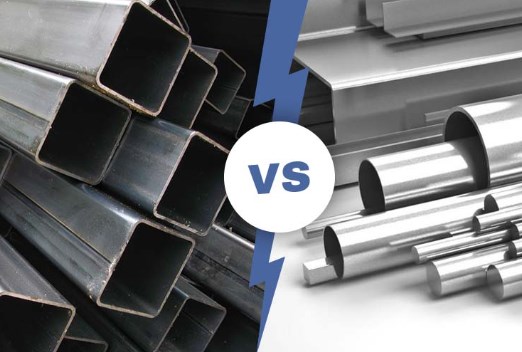When it comes to welding, selecting the appropriate material is crucial for achieving the desired results. Among the myriad of options available, stainless steel and carbon steel are two of the most common choices. Each material possesses unique characteristics that can significantly impact the welding process and the final outcome of a project. To learn to choose stainless steel or carbon steel welding, one must know their differences in properties, advantages, challenges, and welding techniques.

I. Introduction to Stainless Steel and Carbon Steel
Before diving into the comparison, let's briefly understand what sets stainless steel and carbon steel apart:
1) Stainless Steel:
Stainless steel is an alloy of iron with a minimum of 10.5% chromium content. Common grades include 304, 316, and 430, each offering different properties suited for various applications. Its advantages are as follows:
Corrosion Resistance: Stainless steel contains chromium, which forms a passive oxide layer on its surface, providing exceptional resistance to corrosion and oxidation.
Aesthetic Appeal: Stainless steel welds exhibit a clean, polished appearance, making them ideal for architectural applications and decorative purposes.
Hygienic Properties: The smooth surface of stainless steel minimizes the risk of bacterial growth, making it suitable for use in food processing equipment and medical devices.
2) Carbon Steel:
Carbon steel is primarily composed of iron and carbon, with trace amounts of other elements. Carbon steel comes in different grades, such as low-carbon steel (mild steel) and high-carbon steel, each with varying carbon content and properties. Its advantages are as follows:
Cost-Effectiveness: Carbon steel is readily available and economical, making it an attractive option for large-scale welding projects and general fabrication.
Weldability: Carbon steel exhibits good weldability, allowing for ease of joining and fabrication using common welding processes such as stick welding, MIG welding, and TIG welding.
Strength and Durability: Carbon steel offers high tensile strength and durability, making it suitable for applications that require robust and reliable structural components.
II. Challenges of Stainless Steel and Carbon Steel Welding
Although Stainless Steel and Carbon Steel have diverse advantages, they also pose challenges in welding, and the challenges are as follows:
1) Challenges of Stainless Steel Welding:
Sensitivity to Heat: Stainless steel has a low thermal conductivity, making it prone to overheating and distortion during welding.
Precise Welding Techniques: Achieving quality welds with stainless steel requires precise control of heat input and weld parameters to prevent defects such as porosity and cracking.
Cost: Stainless steel typically commands a higher price than carbon steel, which may impact the overall cost of a welding project.
2) Challenges of Carbon Steel Welding:
Susceptibility to Corrosion: Unlike stainless steel, carbon steel is prone to corrosion and rust formation, especially in harsh environments or exposure to moisture.
Material Selection: Choosing the appropriate carbon steel grade is crucial to ensure the desired mechanical properties and performance of the welded structure.
III. Comparison of Welding Techniques:
Now, let's compare the welding techniques used for stainless steel and carbon steel:
1) Stainless Steel Welding:
Stainless steel welding requires precise control of heat and proper shielding to prevent oxidation.
Common welding methods for stainless steel include Tungsten Inert Gas (TIG) welding and Metal Inert Gas (MIG) welding.
TIG welding is preferred for thinner stainless steel materials due to its precision and ability to produce high-quality welds.
MIG welding is suitable for thicker stainless steel sections and provides higher deposition rates, making it more efficient for larger projects.
2) Carbon Steel Welding:
Carbon steel welding is relatively straightforward compared to stainless steel welding.
Common welding processes for carbon steel include Shielded Metal Arc Welding (SMAW), Gas Metal Arc Welding (GMAW), and Flux-Cored Arc Welding (FCAW).
SMAW, also known as stick welding, is versatile and can be used in various positions, making it suitable for outdoor and field welding.
GMAW and FCAW offer higher productivity and are ideal for welding thicker carbon steel sections in industrial settings.
IV. Choose Carbon Steel or Stainless Steel
When deciding between stainless steel and carbon steel welding, consider the following factors:
Corrosion Resistance: If your project involves exposure to corrosive environments, such as coastal regions or chemical processing plants, stainless steel is the preferred choice for its superior corrosion resistance.
Strength and Durability: For structural applications where strength and durability are paramount, carbon steel's high tensile strength and toughness make it an excellent candidate.
Aesthetic Appeal: In applications where aesthetics play a significant role, such as architectural elements or decorative fixtures, the lustrous finish of stainless steel adds a touch of elegance.
Cost Considerations: While stainless steel typically commands a higher price tag due to its corrosion-resistant properties, carbon steel offers a cost-effective solution for budget-conscious projects.
V. Conclusion
In the eternal debate of stainless steel vs. carbon steel welding, there's no one-size-fits-all answer. The choice ultimately hinges on the specific requirements of your project, balancing factors such as corrosion resistance, strength, aesthetics, and budget constraints. By understanding the unique characteristics and challenges of each material, you can make an informed decision that ensures the success and longevity of your welding endeavors. Whether you opt for the enduring allure of stainless steel or the rugged reliability of carbon steel, rest assured that both materials offer a solid foundation for welding excellence.
Related articles:
1. High Carbon Steel Welding Challenges and Solutions Explaination!
2. How to TIG Weld Low Alloy and Carbon Steels?
3. Megmeet Ehave CM 350/400/500 Welder Series: The Epitome of Super-Robust Synergic MIG/MAG Welders for Carbon Steel
4. Stainless Steel Welding Procedure Specifications: A Guide
5. Welding of Various Types of Stainless Steel Pressure Vessels!




